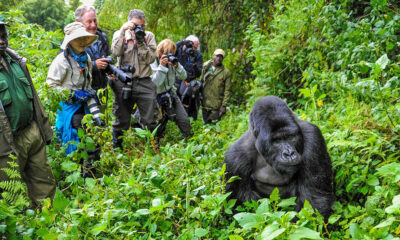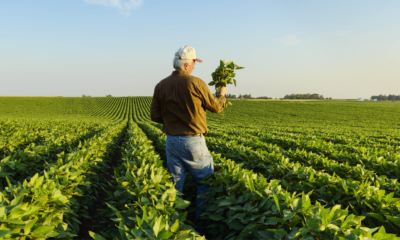human traffickingFeatures
Rwanda: A story of two worlds in two decades

Progress; Deliberate government plans have helped Rwanda achieve rapid economic progress
As a young man continued to paint his way up the stairs in the “Arrivals” section, a delegation that had just landed by RwandaAir from Uganda was descending them for an unrelated but symbolic event-the 2nd Global Conference on Biofortification.
Twenty years earlier Rwanda had torn itself apart as one ethnic group turned guns, machetes and clubs against another. Now, it was hosting an international conference not by affirmative action, but on the merit of multiplying nutritious bean varieties for the proper growth and health of its people-two different worlds in two decades.
A drive from the airport into Kigali, Rwanda’s capital, revealed clean streets and neat buildings as traffic got a bit busier but not congested. There were no skyscrapers to suggest a big economy but there was order enough to indicate a guided growth path. This is not just about Kigali, it is about Rwanda.
The sad mood to engulf the country for months, as genocide survivors and relatives remember the deceased, should not prevent Rwanda’s visitors from noticing that the small East African country, a little over 26,000 square kilometers, is growing in buildings and crops, but, they may not notice what is growing inside the beans and potatoes, some of Rwanda’s most important staple foods.
In the Eastern province, about 75 kilometres from Kigali, farmer Immaculate Mukangarambe’s beans in the field look ordinary by the leaves and stems but they are unique – these ones are rich in iron, which should prevent anemia, a condition which can make the skin pale and cause fatigue.
“These beans are high yielding, disease resistant and provide up to 45% of daily iron needs, which is 14% more than the ordinary beans,” Rwanda Prime Minister Pierre Habumuremyi told over 250 delegates at the opening of the three-day conference on March 31st.
Mukangarambe is growing the beans on seven hactares in an arrangement with the Rwanda Agriculture Board (RAB). When they are harvested in June, the government will distribute them to other farmers.
“I was previously multiplying hybrid maize. I heard about iron-rich beans over the radio and I was curious. I approached RAB and they said it was Ok I could take on the beans as well,” Mukangarambe says. She expects to harvest 14 tons of iron-rich beans.
Rwandan farmers totaling 700, 000 are now growing iron-rich beans, making up almost half of the total number of farmers growing biofortified crops in the selected regions of Africa, Asia and Latin America, which is 1.5 million. In addition to the iron-rich beans, Rwanda is also growing vitamin A biofortified orange sweet potatoes especially to improve nutrition in children and mothers.
What Rwanda is doing is to strategically position its population to not just eat food for the sake of killing hunger but to eat nutritious food for good health.
“In Rwanda once we are convinced that something works we do it,” says Rwanda’s Agriculture and Animal Resources Minister Dr. Agnes Kalibata.
Dr. Howarth Bouis, the man who dreamt 20 years ago that increasing in crops minerals and vitamins such as iron, zinc and vitamin A through biofortification was viable, was among the delegates in Kigali to discussing ways of scaling up the adoption of biofortified crops.
“We have proved that biofortification works. Biofortification can demonstrate cost effectiveness to agriculture and nutrition,” Bouis told the conference.
Rwanda is credited for the speedy spread of the iron-rich beans to cover so many farmers just two years after they were released-the reason for holding the conference in Rwanda.
Biofortified crops, championed by HarvestPlus, the programme Bouis heads, are aimed at reducing anemia, cognitive impairment, visual impairment and other malnutrition related health problems in especially low income countries.
“Nutrient-rich crops are most beneficial to groups that are vulnerable to deficiencies in micro nutrients, such as vitamin A, iron or zinc, including children and pregnant and breast feeding women, and those whose diets are limited by low income or lack of access to diverse, healthy foods,” says a statement from HarvestPlus.
Several countries are at different stages of growing biofortified crop varieties in Africa, Asia and Latin America with HarvestPlus targeting a billion farmers by 2030. Varieties of vitamin A enriched orange sweet potatoes have been grown in Uganda since 2007, there are now about 150,000 farmers growing them.
In Zambia three varieties of vitamin A fortified orange maize are being promoted. Coloured maize, however, is not popular in many parts of Africa as it is associated with crisis including war, HIV/AIDS and recently, genetic modification.
In Nigeria vitamin A fortified yellow cassava is reported to me making high success in the south where consumers were already used to mixing white cassava with palm oil. Nigeria’s Agriculture and Rural Development Minister Akinwumi Adesina admits they will need to convince the rest of the country about the nutritional value of the yellow cassava.
In Pakistan breeding of biofortified zinc wheat is said to be at an advanced stage at the Pakistan Agricultural Research Council (PARC) in Islamabad.
Other countries including Ethiopia, the Democratic Republic of Congo, Bangladesh, India and Brazil are either growing or are a target for biofortified crops.
Rwanda may posses a small area for agriculture but its swift adaptability to new technologies may enable it sufficiently feed its people, that is if the policy environment remains supportive.
Comments


















